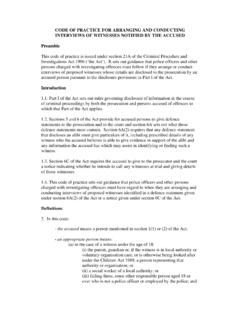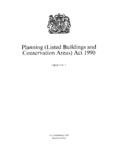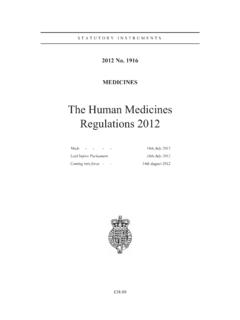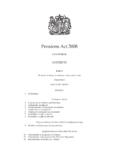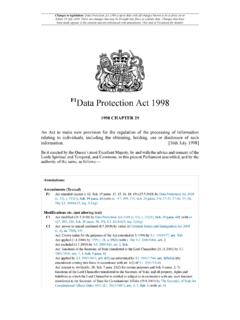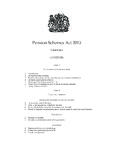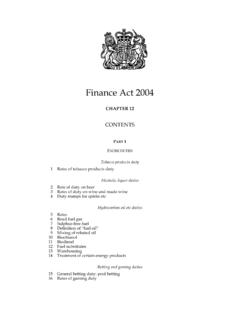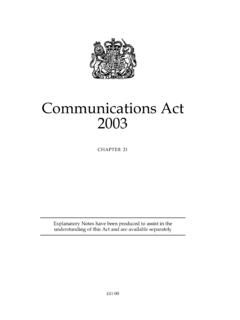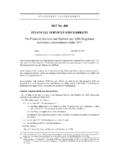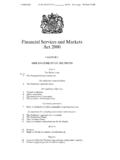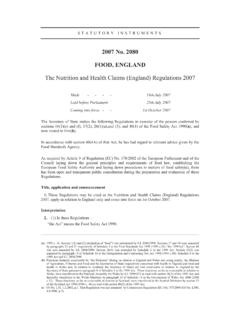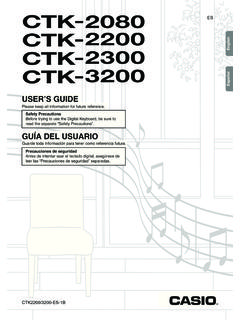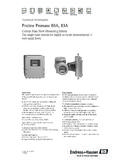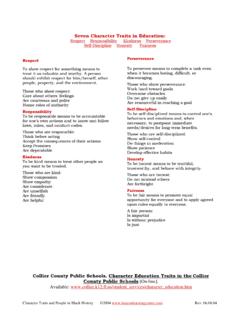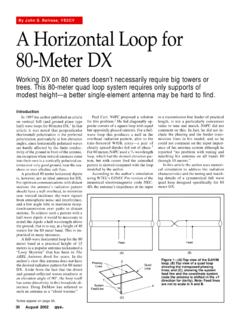Transcription of 2014 No. 2080 BANKS AND BANKING - Legislation.gov.uk
1 S T A T U T O R Y I N S T R U M E N T S 2014 No. 2080 BANKS AND BANKING The financial Services and Markets Act 2000 (Excluded Activities and Prohibitions) Order 2014 Made - - - - 23rd July 2014 Coming into force in accordance with article 1(2) and (3) In accordance with section 142Z of the financial Services and Markets Act 2000, a draft of this Order has been laid before Parliament and approved by a resolution of each House of Parliament. The Treasury make the following Order in the exercise of the powers conferred on them by sections 142D, 142E and 142F of the financial Services and Markets Act 2000(a). PART 1 GENERAL Citation, commencement and interpretation 1. (1) This Order may be cited as the financial Services and Markets Act 2000 (Excluded Activities and Prohibitions) Order 2014. (2) This article, articles 2 and 3 and the Schedule to this Order come into force on 1st January 2015.
2 (3) The other provisions of this Order come into force on 1st January 2019. (4) In this Order account holder means any person, other than a relevant financial institution, who has an account with a ring-fenced body(b); the Act means the financial Services and Markets Act 2000; alternative investment fund means an AIF within the meaning of Article 4(1)(a) of the Directive of the European Parliament and of the Council of 8 June 2011 on alternative investment fund managers(c); alternative investment fund manager means an AIFM within the meaning of Article 4(1)(b) of the Directive of the European Parliament and of the Council of 8 June 2011 on alternative investment fund managers; (a) 2000 c. 8. Sections 142A to 142Z1 were inserted into the Act by the financial Services ( BANKING Reform) Act 2013 ( ), section 4.
3 (b) Ring-fenced body is defined in section 142A of the Act. (c) Directive 2011/61/EU, OJ L174, , p1. 2 building society means a building society incorporated (or deemed to be incorporated) under the Building Societies Act 1986(a); capital market arrangement has the meaning given in paragraph 1 of Schedule 2A to the Insolvency Act 1986(b); commodity means any goods of a fungible nature that are capable of being delivered including metals and their ores and alloys, agricultural products, and energy such as electricity; conduit vehicle of a ring-fenced body means an undertaking which satisfies the conditions set out in article 17(2) for the relevant financial institution described as D; correspondent BANKING means an arrangement between two credit institutions pursuant to which one credit institution provides payment services to the clients of the other credit institution on behalf of that credit institution.
4 Covered bond vehicle means a body corporate, partnership or unincorporated association (a) which is a party to a capital market arrangement, or a transaction in pursuance of a capital market arrangement, and (b) whose business consists (apart from incidental activities) only of (i) providing guarantees, and (ii) acquiring, owning and managing assets directly or indirectly forming the whole or part of the security for a capital market arrangement; credit institution has the meaning given in Article (1) of the prudential requirements regulation; credit institutions directive means the Directive of the European Parliament and of the Council of 26 June 2013 on access to the activity of credit institutions and the prudential supervision of credit institutions and investment firms, amending Directive 2002/87/EC and repealing Directives 2006/48/EC and 2006/49/EC(c); credit union means a credit union as defined by section 31 of the Credit Unions Act 1979(d) or a credit union as defined by Article 2(2) of the Credit Unions (Northern Ireland) Order 1985(e); debentures include any investment of the kind specified by article 77 of the Regulated Activities Order 2001(f).
5 Default risk , in relation to a ring-fenced body, means the risk that (a) one or more persons will default under a transaction with a ring-fenced body or with a subsidiary undertaking of the ring-fenced body or will become unlikely, unwilling or unable to pay or repay sums owing at law or in equity to the ring-fenced body or to a subsidiary undertaking of the ring-fenced body, (b) an obligation to pay or repay sums owing at law or in equity to the ring-fenced body or to a subsidiary undertaking of the ring-fenced body will be restructured so as to reduce or postpone the payments due as principal, interest or fees resulting in a loss to the ring-fenced body or to its subsidiary undertaking, or (c) the value of any security or collateral taken by the ring-fenced body or a subsidiary undertaking of the ring-fenced body in connection with one or more transactions entered into by the ring-fenced body or its subsidiary undertaking will be insufficient to meet the (a) 1986 c.
6 53. (b) 1986 Schedule 2A was inserted by the Enterprise Act 2002 ( ) s. 250(2) and Schedule 18. Paragraph 1 of that Schedule was amended by SI 2003/1468. (c) Directive 2013/36/EU, OJ L 174 , p338. (d) 1979 c. 34. Section 31 has been amended by the Co-operative and Community Benefit Societies and Credit Unions Act 2010 ( ), section 2. (e) 1985/1205 ( 12). (f) SI 2001/544. Article 77 was amended by 2010/86; 2011/133. 3 obligations of the counterparty to the transaction when the security is enforced or the collateral is sold; and for the purposes of paragraph (b), restructuring includes restructuring through a voluntary arrangement made with creditors, by court order or through the exercise of powers under the BANKING Act 2009 or in equivalent legislation in other countries) derivative instrument includes any of the instruments listed in paragraphs (4) to (10) of Section C of Annex 1 to the markets in financial instruments directive; exposure means (a) an asset referred to in Part Three, Title II, Chapter 2 of the prudential requirements regulation, or (b) an off-balance sheet item listed in Annex I to the prudential requirements regulation(a), without applying the risk weights or degrees of risk set out in the prudential requirements regulation.
7 financial holding company means a financial institution which is not a mixed financial holding company, the subsidiary undertakings of which are either exclusively or mainly credit institutions, investment firms or financial institutions and which has at least one subsidiary undertaking which is a credit institution or investment firm, and for the purposes of this definition, a financial institution is an undertaking other than a credit institution, the principal activity of which is to acquire holdings or to pursue one or more of the activities listed in points 2 to 12 and 15 of Annex I to the credit institutions directive; financial institution exposure means an exposure to a relevant financial institution or an exposure to securities or other financial instruments issued by a relevant financial institution, but does not include an exposure where the sole or main purpose for which the ring-fenced body incurs the exposure to the relevant financial institution is to provide for (a) the safeguarding and administration of assets of the ring-fenced body by that financial institution, or (b) client money or client assets to be held for the ring-fenced body by that relevant financial institution.
8 Global systemically important insurer means an insurance undertaking, third country insurance undertaking, reinsurance undertaking or third country reinsurance undertaking which is included on the list of global systemically important insurers published by the financial Stability Board on 18 July 2013, or on any updated version of that list or supplementary list of such undertakings published by the financial Stability Board; instruments giving an entitlement to shares or debentures includes any instrument of the kind specified by article 79 (instruments giving entitlements to investments) of the Regulated Activities Order 2001(b) which relates to shares or, as the case may be, debentures; insurance undertaking has the meaning given in Article of the solvency II directive(c); interest rate swap has the meaning given in article 10(2)(c); liquid assets means assets which qualify towards the liquidity coverage requirement provided for in Article 412 of the prudential requirements regulation as further specified in delegated acts adopted by the European Commission under Article 460 of that regulation; (a) OJ L 176, , p1.
9 (b) Article 79 of the Regulated Activities Order 2001 was amended by 2010/86. (c) OJ L 335, , p1. 4 liquidity risk means the risk that the ring-fenced body does not have, or is unable to obtain, sufficient financial resources to enable it to meet its financial obligations as they fall due; management company has the meaning given in Article (b) of the UCITS directive(a); mixed financial holding company means an undertaking which is not a credit institution, an insurance undertaking or an investment firm, which has at least one subsidiary undertaking which is a credit institution, an insurance undertaking or an investment firm and which, together with its subsidiary undertakings, constitutes a financial conglomerate (within the meaning given by Article of Directive 2002/87/EC of the European Parliament and of the Council of 16 December 2002(b) on the supplementary supervision of credit institutions, insurance undertakings and investment firms in a financial conglomerate (disregarding any decision taken under Article 3(3) of that directive); own funds means own funds as defined in Article (118) of the prudential requirements regulation.)
10 Payment exposures means (a) in the case of foreign exchange transactions, exposures incurred in the ordinary course of settlement; (b) in the case of transactions for the purchase or sale of securities, exposures incurred in the ordinary course of settlement; (c) exposures arising from the provision of money transmission including (i) the execution of payment services, (ii) clearing and settlement in any currency, and (iii) correspondent BANKING ; and (d) exposures incurred by the ring-fenced body to satisfy a condition required for participation by it in an inter-bank payment system (as defined in section 182 of the BANKING Act 2009)(c) or in the services provided by a recognised clearing house(d), an EEA central counterparty(e) or a third country central counterparty(f) provided that such exposures are only to a relevant financial institution which is also a member or operator of the inter-bank payment system or a member of the relevant recognised clearing house, EEA central counterparty or third country central counterparty; payment services has the same meaning as in regulation 2(1) of the Payment Services Regulations 2009(g).
